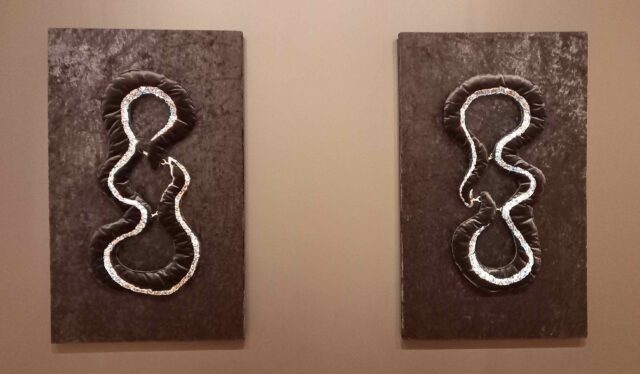What was it that drew you to the juxtaposition of Christian and Māori mythologies?
It’s to do with my Dad’s side of the family – my Pākehā side of the family – being Salvation Army. It’s not where I put my beliefs, but it’s still part of my whakapapa. We also did a lot of research at the beginning of this year about mana wahine and how those customary stories have been changed because of Christian ideals and colonisation, and I wanted to put wahine at the forefront of those stories again.
Did it involve research into the original forms of Māori stories?
It was more reading into the nuances of our customary stories. I don’t think much of the original stuff solidly survived, unfortunately. But there’s been a lot of academic writing done. Actually I was lucky enough to be given a lot of mana wahine writing, which was really cool. Like the character of Mahuika and how she became a side character to Maui and didn’t have autonomy over her own decisions, which you can read into when you read the story.
Were there any characters that leapt out at you and you knew you wanted to represent them?
Yeah, I think the story of Hine-nui-te-Pō and Maui. I think often Hine-nui-te-Pō is portrayed as a villain for killing Maui, but actually he, without her consent, tried to gain immortality through her, and I think it’s important to realise that broke a boundary for her and that’s why he died. He probably deserved it a little bit! I think it’s an important way of flipping that story, that I wanted to tell.
How do you bring these women out in their stories through your artwork?
I represent them with the symbolism, like the kina: I chose it because Hine-nui-te-Pō has these obsidian teeth, and I feel like the spikes of the kina, the black spikes, really bring that forward, as well as the shape and the droplets of blood coming out of the middle that look like the guts of the kina when you break it open. Also there’s Mahuika represented in the flame on the heart. Just little things I feel you can read into them.
Do you have a background in jewellery?
My mum’s a jeweller, so she taught me a lot of stuff. This is my first time making big pieces, but last year I learned how to make wax castings and make them into rings, cast them into solid silver. So this is kind of like a big sized-up version of that – not that they’re all solid silver, but I did do all the metalsmithing on them.
The eels are very intricate.
I did all the beading with muka, so all the thread that was used I extracted it myself from the harakeke, then I beaded every single bead by hand. It took a while!
Was it important to work from first principles like that?
I think so. It means that the practice of beading in my work is more grounded. Rather than being just something I like the look of, it’s also grounded in customary practices.
What do you want people to take away from viewing your work?
I think I’d like them to create a space for healing from the colonisation and trauma of those religious aspects being pushed on us, and probably think a little more critically about the stories that they’ve heard and grown up with – maybe not calling them “myths” but instead “cosmological stories” or “origin stories”. It’s going to take a while! I don’t think people will come to that conclusion very quickly.
What do you plan to do next?
Post-grad. I’d like to do more work with the practice of using manu. I learned this year the practice of skinning a manu to keep it whole and keep the feathers intact, and that’s what is there now. I’d like to do more of that – and with intention, not just taxidermy!
People might see it and say “oh that’s sad”, but there’s a reverence to it, isn’t there.
Yes. You look at a korowai and you see a beautiful piece of art – I think you can look at the bird it comes from the same way.
 Aroha Millar, He Ika Paewai Anake Hei Tomo i roto
Aroha Millar, He Ika Paewai Anake Hei Tomo i roto
i te Hīnaki (My trap only catches big eels), 2022




